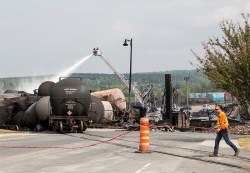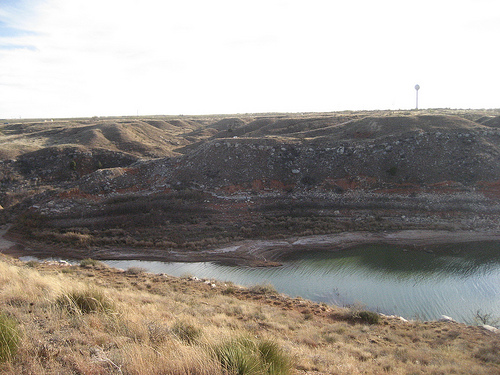
Prime Minister Stephen Harper’s Flickr accountA pile of DOT-111 oil tankers in Lac-Mégantic following the July 6 derailment and explosion.
Soda can–shaped rail cars like those that exploded in Lac-Mégantic, Quebec, earlier this month shouldn’t be on America’s train tracks. They are prone to rupture in accidents.
Yet these so-called DOT-111 railway cars will continue to haul most of the oil that’s moved through the U.S. by rail at least into next year and likely beyond.
After an investigation into a deadly 2009 explosion of an ethanol-laden train in Illinois, the National Transportation Safety Board called for a redesign or replacement of DOT-111 cars, noting that their thin steel shells can easily puncture and that valves can break during rollovers.
The Obama administration has been working on rules to reduce the hazards of the dangerous railway cars, but those rules have been delayed by nearly a year, the AP reports. And it’s unclear whether new regulations would apply to an estimated 40,000 older DOT-111’s now in use or only to newer ones.
As the North American oil boom fills up pipeline systems, oil companies are turning to rail to move their combustible product across Canada and the U.S., particularly in DOT-111 oil tankers. From the AP article:
A proposed rule to beef up rail-car safety was initially scheduled to be put in place last October, but it has been delayed until late September at the earliest. A final rule isn’t expected until next year.
The [Pipeline and Hazardous Materials Safety Administration] said in a report this month that the latest delay was needed to allow “additional coordination” among officials and interested groups, including industry representatives who have resisted calls to retrofit existing cars, citing the expense and technical challenges such a requirement would pose.
In the first half of this year, U.S. railroads moved 178,000 carloads of crude oil. That’s double the number during the same period last year and 33 times more than during the same period in 2009.
The railroad and oil industries claim that retrofitting the nation’s entire fleet of DOT-111 tanker cars would cost more than $1 billion.
Meanwhile, Canadian press outlets are reporting that it could yet be weeks before we get a full assessment of the damages caused by the deadly explosion that destroyed the downtown area of Lac-Mégantic.



